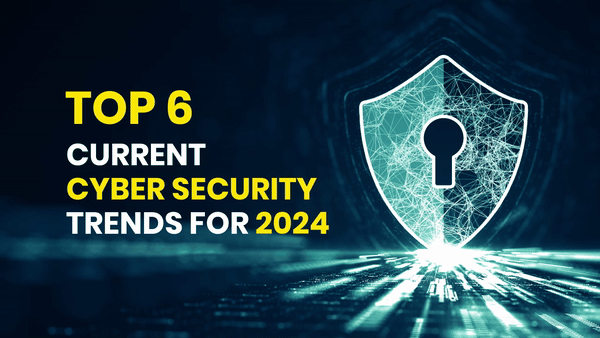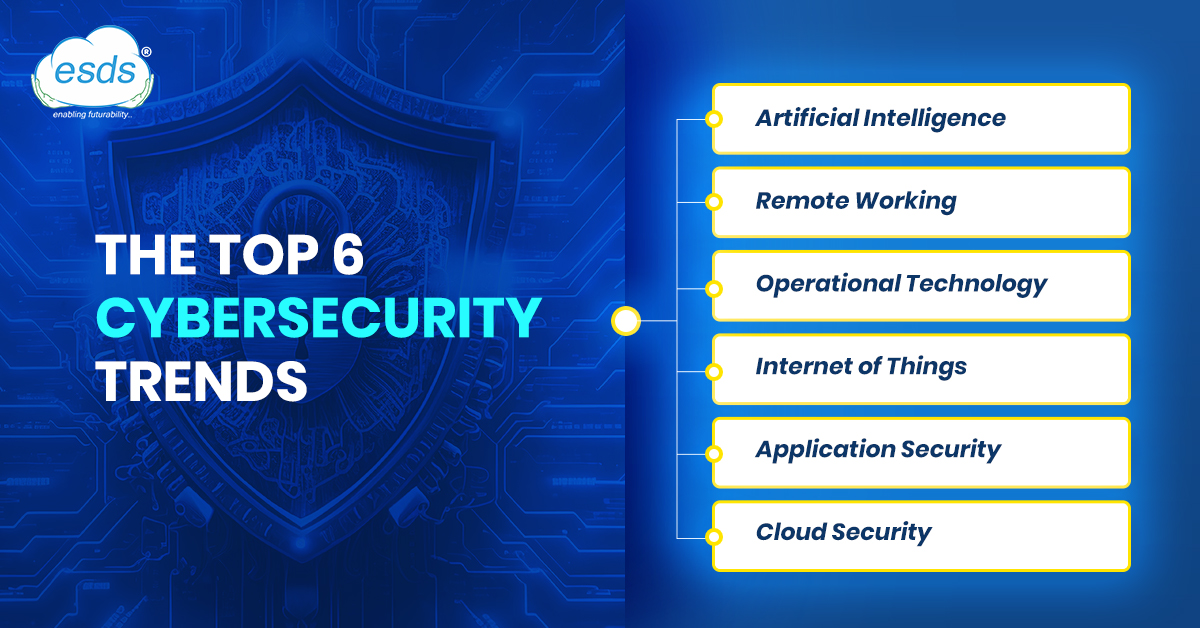Top 6 Current Cybersecurity Trends For 2024

In the ever-evolving digital landscape, where innovation and progress go hand in hand, the importance of cybersecurity cannot be overstated. The rapid expansion of technology brings forth a host of opportunities, but with it emerges an array of cybersecurity threats that demand our attention. To navigate this intricate web of risks and safeguards, it is imperative to stay abreast of the latest trends shaping the cybersecurity landscape. Here we delve into the top 10 current and influential cybersecurity trends, examining the intricacies of each and shedding light on effective strategies to mitigate associated risks.
Whether you are striving to capitalize on these trends or fortify your defenses against them, understanding the dynamics of cybersecurity is paramount in safeguarding your organization from an ever-growing spectrum of threats.
We’ll look at the top 10 cybersecurity trends that are currently influencing the market in this blog and talk about how to properly address each one.
Artificial Intelligence
With all of the excitement surrounding ChatGPT and its pros and cons when it comes to cybersecurity, artificial intelligence (AI) is becoming a more significant factor in cybersecurity. More and more machine learning algorithms are being utilized to better identify and stop cyberattacks.
The Capgemini Research Institute reports that 69% of organizations think AI would be crucial for combating cyberattacks in the next years, underscoring the technology’s increasing importance in the field of cybersecurity. Organizations need to be aware of both the possible drawbacks and advantages of the new era of artificial intelligence, just like with any new technology. It is common knowledge that cybercriminals take use of new technologies for advancing their own agendas.
Remote Working
Over the past few years, there has been a significant increase in remote work, with many companies implementing flexible work-from-home or hybrid working policies.
Although this has given businesses more operational freedom, it has also made it easier for cyber criminals to launch attacks.
A survey revealed that in 2020, as the COVID-19 epidemic spread over the globe, 20% of organizations suffered a security breach as a result of remote working. Even as we get more understanding of how to function in a hybrid world, these threats persist. This reinforces how important it is to have strong cybersecurity guidelines for remote employees as we adopt these new working practices.

Operational Technology
Systems and equipment used in the manufacturing, transportation, energy, and key national infrastructure sectors are examples of industrial processes that are monitored and controlled by operational technology (OT).
These systems are more prone to cyberattacks as they are connected to the internet more and more. Improved OT cybersecurity is desperately needed, as evidenced by the fact that 90% of organizations surveyed in the industry reported at least one OT cybersecurity breach in the previous year.
Internet of Things (IoT)
The Internet of Things, or IoT, has radically transformed the way we work and live. By 2030, there will be 50 billion linked gadgets globally. But is IoT a friend or a threat?
IoT devices are high-value targets for cyber criminals because they frequently lack the security protections seen in traditional IT systems. 57% of IoT devices are at risk of medium- or high-severity attacks, according to industry research, underscoring the need for stronger IoT security protocols.
Application Security
The growing use of online applications and the popularity of mobile devices have made application security an essential component of cybersecurity. In fact, a Verizon Data Breach Investigations Report states that web apps are currently the target of 43% of assaults.
This suggests how crucial it is to protect programs against flaws and possible hacker attacks. Apps need to be “secure by design.” Regular web application penetration testing will help you find loopholes and eliminate risks to your business.
Cloud Security
Strong cloud security measures are becoming more and more important as more companies move to cloud-based services for data processing and storage. The organizations working with cloud service providers must exercise caution in establishing cloud environments due to the shared security responsibility paradigm, ensuring they avoid vulnerability to attacks.

In Summary
As we conclude our exploration of the top 10 cybersecurity trends, one undeniable truth emerges—cybersecurity is a dynamic and ever-shifting battleground. The integration of artificial intelligence, the surge in remote work, the vulnerabilities in operational technology, the proliferation of Internet of Things devices, the necessity of robust application security, and the escalating reliance on cloud services all underscore the multifaceted nature of the challenges we face. In this fast-paced digital era, staying ahead of cyber threats demands constant vigilance, adaptive strategies, and a commitment to evolving security measures. As we move forward, the symbiotic relationship between technological advancement and cybersecurity will continue to define the digital landscape. The question is not whether the threat landscape will change, but how prepared we are to navigate its complexities and secure a resilient future for our digital endeavors.
Frequently Asked Question (FAQs)
-
What are the current top trends in cybersecurity?
The topmost in current cybersecurity trends are:
- The rise of Automotive Hacking
- The potential of Artificial Intelligence
- The emerging threat to Mobile Devices
-
What are the emerging cybersecurity trends in 2024?
In 2023, the following are the top cybersecurity trends to keep an eye on.
- The Rise of Automotive Hacking
- Artificial Intelligence’s (AI) Potential
- The New Target – Mobile Device
- The Cloud May Be Vulnerable As Well
- Data Breach: A high-priority target
- The Internet of Things on a 5G Network: Technology and Risks in a New Era
- Integration and automation
-
What are the major cybersecurity threats in 2024?
- Cyber hygiene
- Vulnerabilities in the Cloud
- Vulnerabilities in Mobile Devices
- The Internet of Things (IoT)
- Ransomware
- Lack of data management
- Inadequate Post-Attack Procedures
- Keeping a track of everything
-
What are the latest advancements in cybersecurity?
Machine Learning and Artificial Intelligence
Artificial intelligence (AI) and machine learning have made significant contributions to the progress of cybersecurity. By modelling network activity and enhancing overall threat detection, machine learning is being used to identify harmful conduct by hackers.
-
What do you think the future of cybersecurity will be like?
AI, along with machine learning, has resulted in major gains in cybersecurity, with AI being applied across all market sectors. AI has played a crucial role in the development of automated security systems, natural language processing, face recognition, and autonomous threat detection.
- 6 Ways AI Reinvents the Security Landscape - January 9, 2024
- Top 6 Current Cybersecurity Trends For 2024 - January 9, 2024
- What Have We Learned from The Recent Cybersecurity Incidents? - January 3, 2024
